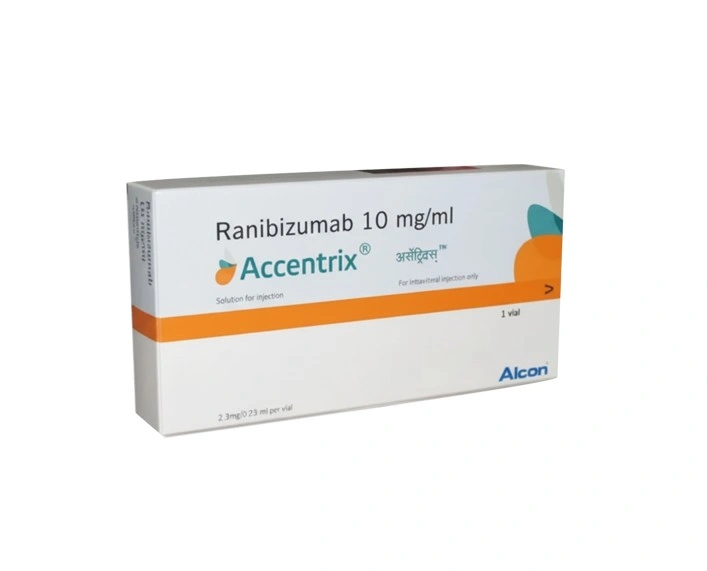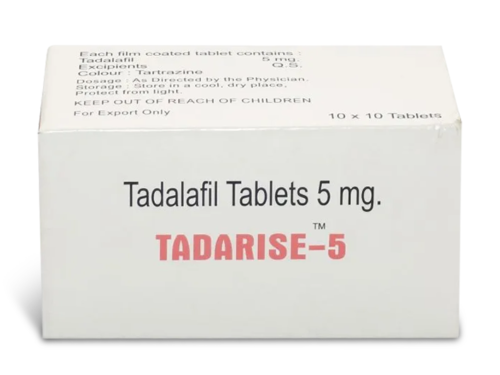Accentrix Solution for Injection
Accentrix Solution for Injection is an intravitreal ophthalmic solution with ranibizumab as the active ingredient.
Price range: $898.50 through $2,582.11
Availability: IN STOCK
Accentrix Solution for Injection is an intravitreal ophthalmic solution with ranibizumab as the active ingredient. This recombinant humanized monoclonal antibody fragment targets VEGF-A and is prescribed by retinal specialists for wet age-related macular degeneration (AMD), diabetic macular edema (DME), macular edema secondary to retinal vein occlusion (RVO), and other retinal diseases with pathologic neovascularization and leakage. Accentrix is supplied as a sterile solution in vials or prefilled syringes for administration by an ophthalmologist in a clinical setting.
Key Features
| About Accentrix Solution for Eye Injection | |
|---|---|
| Drug Class | Anti-angiogenic ophthalmic agents |
| Subclass | Intravitreal anti-VEGF injection |
| Product Details | |
|---|---|
| Composition | Active ingredient: Ranibizumab |
| Packaging Type | Single-use vials or prefilled syringes |
| Pack Size | Typically, 0.1 ml or 0.2 ml solution for injection |
| Dosage | 0.5 mg (0.05 ml) per injection |
| Therapeutic class | Ophthalmic anti-inflammatory, immunosuppressive agent |
| Action Class | Calcineurin inhibitor |
| Chemical class | Cyclic polypeptide |
| Manufacturer | Allergan/Novartis (regional variation) |
| Shelf Life | 2-3 years from manufacturing date |
| Usages | Treatment of wet AMD, DME, RVO-related macular edema, and other vascular retinal diseases |
| Country of Origin | Varies (commonly India/USA/EU) |
| Storage | Store refrigerated (2–8°C), protect from light. See label for room-temperature details prior to use. |
How Accentrix (ranibizumab) Works
Ranibizumab binds with high affinity to VEGF-A, blocking activation of VEGF receptors on endothelial cells. This suppresses abnormal new blood vessel growth (neovascularization) and vascular leakage in the retina, reducing macular edema and bleeding, and preserving central vision. Intravitreal administration ensures high concentration at the retinal site with minimal systemic exposure. Clinical benefit follows anatomic and functional improvement as neovascular activity is suppressed.
Indications / Uses
- Wet age-related macular degeneration (AMD): Reduces vision loss and may improve vision by targeting choroidal neovascularization.
- Diabetic macular edema (DME), diabetic retinopathy: Reduces macular swelling, improving vision in patients with diabetes.
- Macular edema secondary to retinal vein occlusion (RVO): Reduces swelling and improves vision after retinal vein blockages.
Only administered by an ophthalmologist or retina specialist trained in intravitreal injection.
Dosage & How to Use
- Important: Only trained specialists should perform intravitreal injections under sterile conditions in a clinical setting.
- Typical adult dose: 0.5 mg (0.05 ml) per dose, given as a single intravitreal injection. Often monthly for induction, then individualized maintenance (e.g., treat-and-extend or PRN regimens).
- Preparation: Withdraw the required dose with a sterile needle under aseptic conditions. Prefilled syringes may be available.
- Administration: After topical anesthetic and antiseptic prep, inject into the vitreous cavity via the pars plana. Assess intraocular pressure and eye condition post-injection; observe the patient briefly.
- Follow-up: Regimen is guided by indication, initial response, and imaging; OCT monitoring sets retreatment intervals.
Expected Benefits
- Stabilization or improvement of visual acuity: Many patients gain or maintain vision with reduced neovascular leakage and edema.
- Anatomic restoration: Macular thickness reduces, intra-/subretinal fluid resolves on OCT.
- Lower risk of progression: Reduces likelihood of hemorrhage, scarring, and further vision loss from unchecked vessel growth.
Side Effects
Most side effects are ocular, relating to procedure or drug action. Serious or systemic effects are rare.
Common/procedure related
- Injection-site discomfort, conjunctival hemorrhage, eye pain, foreign body sensation (transient).
- Transient increase in intraocular pressure after injection.
Serious/less common
- Endophthalmitis (serious infection), retinal detachment, vitreous hemorrhage, traumatic cataract.
Systemic (uncommon)
- Rare systemic VEGF-inhibition risks (arterial thrombotic events, e.g., stroke). Monitor patients with recent cardiovascular events.
Report severe pain, sudden vision loss, or pronounced redness urgently.
Interactions & Important Clinical Notes
- Coordinate with other ocular medications; space intravitreal agents as clinically appropriate.
- Notify your ophthalmologist if taking systemic VEGF inhibitors or after recent major cardiovascular events.
- Avoid injection if the eye has an active infection; treat infections prior to therapy.
Pharmacokinetics
After intravitreal injection, ranibizumab is distributed in eye tissues. Systemic absorption is limited and transient, with lower half-life than full monoclonal antibodies, minimizing systemic risk. See product labeling for region-specific pharmacokinetic details.
Precautions & Who Should Be Careful
- Avoid in known hypersensitivity to ranibizumab or formulation components.
- Defer in active eye infection or inflammation.
- Use caution in cardiovascular disease (recent stroke, MI); judge risk/benefit per patient.
- Limited data in pregnancy/breastfeeding; use only if clearly needed under specialist guidance.
Storage & Handling
- Store refrigerated per label. Use aseptic technique, discard unused material as per protocols. Keep out of reach of children.
Practical Tips & Realistic Expectations
- Visual improvements may require multiple injections—results vary from stabilization to significant gain.
- OCT and regular eye exams guide ongoing management—expect possible repeat/maintenance injections.
- Education on post-injection warning signs and access to urgent care reduce risk of serious complications.
Conclusion
Accentrix (ranibizumab) intravitreal injection is an established anti-VEGF therapy for sight-threatening macular diseases (wet AMD, diabetic and post-RVO macular edema). When given by a retina specialist with sterile technique and regular follow-up, it can prevent further vision loss and improve outcomes for many patients. Benefits must be balanced with procedural risks and ongoing disease monitoring.
FAQ’s
1) Who administers Accentrix injections?
Only trained ophthalmologists or retina specialists in clinical settings—never by patients themselves.
2) How soon will I see a benefit?
Some notice anatomic/symptomatic improvement after 1–2 injections; optimal results require ongoing treatment and monitoring.
3) Is the procedure painful?
Local anesthetic is used; most patients feel brief pressure or mild discomfort, but tolerate it well.
4) What are the warning signs after injection?
Severe eye pain, vision loss, increasing redness, or discharge should prompt immediate emergency consultation.
References
| Select Injections | 2 Injection, 4 Injection, 6 Injection |
|---|







Shia Baretto –
I received Accentrix Solution for Injection as part of my treatment, and it has shown great results. My condition improved noticeably after consistent use